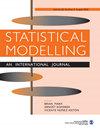The Skellam distribution revisited: Estimating the unobserved incoming and outgoing ICU COVID-19 patients on a regional level in Germany
IF 1.2
4区 数学
Q2 STATISTICS & PROBABILITY
引用次数: 0
Abstract
With the beginning of the COVID-19 pandemic, we became aware of the need for comprehensive data collection and its provision to scientists and experts for proper data analyses. In Germany, the Robert Koch Institute (RKI) has tried to keep up with this demand for data on COVID-19, but there were (and still are) relevant data missing that are needed to understand the whole picture of the pandemic. In this article, we take a closer look at the severity of the course of COVID-19 in Germany, for which ideal information would be the number of incoming patients to ICU units. This information was (and still is) not available. Instead, the current occupancy of ICU units on the district level was reported daily. We demonstrate how this information can be used to predict the number of incoming as well as released COVID-19 patients using a stochastic version of the Expectation Maximization algorithm (SEM). This, in turn, allows for estimating the influence of district-specific and age-specific infection rates as well as further covariates, including spatial effects, on the number of incoming patients. The article demon-strates that even if relevant data are not recorded or provided officially, statistical modelling allows for reconstructing them. This also includes the quantification of uncertainty which naturally results from the application of the SEM algorithm.重新审视斯凯拉姆分布:估算德国地区一级未观察到的 ICU COVID-19 病人进出情况
随着 COVID-19 大流行的开始,我们意识到需要收集全面的数据,并提供给科学家和专家进行适当的数据分析。在德国,罗伯特-科赫研究所(RKI)一直在努力满足对 COVID-19 数据的需求,但过去(现在仍然)缺少了解大流行全貌所需的相关数据。在这篇文章中,我们将仔细研究 COVID-19 在德国的严重程度,其中最理想的信息是重症监护室的入院病人数量。这一信息过去无法获得(现在也无法获得)。取而代之的是每天报告的地区一级重症监护病房的当前占用率。我们展示了如何利用这一信息,通过随机版本的期望最大化算法(SEM)来预测 COVID-19 病人的入院和出院人数。这反过来又可以估计特定地区和特定年龄的感染率以及其他协变量(包括空间效应)对新来患者人数的影响。文章证明,即使官方没有记录或提供相关数据,也可以通过统计建模来重建这些数据。这还包括应用 SEM 算法自然产生的不确定性的量化。
本文章由计算机程序翻译,如有差异,请以英文原文为准。
求助全文
约1分钟内获得全文
求助全文
来源期刊

Statistical Modelling
数学-统计学与概率论
CiteScore
2.20
自引率
0.00%
发文量
16
审稿时长
>12 weeks
期刊介绍:
The primary aim of the journal is to publish original and high-quality articles that recognize statistical modelling as the general framework for the application of statistical ideas. Submissions must reflect important developments, extensions, and applications in statistical modelling. The journal also encourages submissions that describe scientifically interesting, complex or novel statistical modelling aspects from a wide diversity of disciplines, and submissions that embrace the diversity of applied statistical modelling.
 求助内容:
求助内容: 应助结果提醒方式:
应助结果提醒方式:


